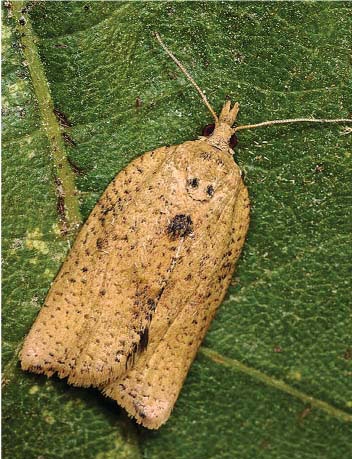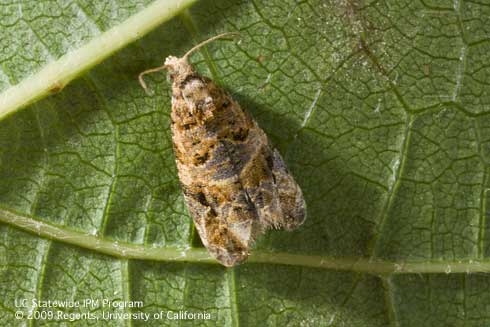Posts Tagged: light brown apple moth
Sonoma County grape growers face a triple threat
“Invasive pests are a problem,” said Nick Frey, president of the Sonoma County Winegrape Commission. “They threaten California agriculture in general, and probably our ecology too, so it’s important to try to prevent their import into the state, and if they do get here, to detect them early. If you don’t get early detection, your odds of eradication are low.”
Rhonda Smith, UC Cooperative Extension advisor in Sonoma County, said local citizens also need to understand and comply with rules to prevent the introduction and spread of invasive species.
“The bottom line is, follow the rules,” Smith said, “because ultimately, the result is pretty dramatic. And who pays the price for that? We pay the price for the enormous effort to eradicate something once it’s here, and/or, we completely lose that industry. We then begin to eat more fruits and vegetables we don’t grow here in California.”
'Two-way learning' embraced
Tim Hearden, Capital Press
Rick Buchner, UC Cooperative Extension advisor in Tehama County, was featured as a "Western Innovator" in a Capital Press story published yesterday. In the article, he explained how the UCCE two-way learning model - involving UC academics and farmers - has been successful in solving agricultural problems.
"The beauty of extension is that we all learn together," Buchner said. "The growers know things that I don't, and I hopefully can share things from the university that they don't know. When we work together, it's a pretty powerful team."
Light brown apple moth eradication unlikely
A recently certified report on light brown apple moth asserts that the pest, native to Australia, cannot be eradicated from California.
"Given the increases in LBAM population densities and the extent of contiguous spread of LBAM observed over the past 2 years, coupled with a lack of area-wide management tools, eradication is no longer feasible in California," the USDA report says.
The "area-wide management tools" referred to in the report includes aerial pheromone spraying, which drew the ire of many environmentalists. Instead, control will be attempted with twist-ties that release pheromones and with the release of sterile moths to disrupt breeding.
According to the AAAS ScienceInsider blog by Ingfei Chen, CDFA concurs with the USDA finding. The agency's main goal is to "contain, control and suppress" the pest, Chen wrote. An article in the Stockton Record said ag officials will still try to eradicate small, discrete infestations such as those found in Manteca and Tracy.In an article about the strategy change, the Santa Rosa Press Democrat noted that the January-March 2010 issue of UC's California Agriculture journal included a peer-reviewed article about LBAM control in New Zealand. The article said the moth “is successfully managed” there with modern pest control techniques. LBAM was an economically important pest from the 1960s to 1980s in New Zealand, and developed resistance to broad-spectrum insecticides, but today a combination of biological control and judicious use of selective insecticides keep LBAM at bay.
Chen said in her blog that the new focus on pest control, rather than eradication, is what some critics of LBAM eradication, including UC Davis biodemographer James Carey, have been advocating for some time. Chen is the author of a lengthy profile of Carey and his LBAM views that appeared on the AAAS Science Web site in January.

LBAM is in California to stay.
Challenging times for California farmers
As if native weeds, diseases and insects weren't enough, California farmers seem to be facing ever increasing numbers of imported pests from far flung corners of the globe.
That fact prompted the Napa Valley Register to run a story about "Moth wars" which detailed battles underway to combat light brown apple moth, a pest from Australia, and European grapevine moth, an Italian native that has caused serious grapevine damage in Uzbekistan and Azerbaijan.
The European grapevine moth "snuck in under the radar" about the same time agricultural officials were beginning releases of sterile light brown apple moth, the story said. For three years, officials have been trying keep the light brown apple moth from becoming permanently established in California.
They have tried spraying in Santa Cruz County and placed pheromone traps in various cites. In the Carneros region, agricultural officials began releasing sterile male and female apple moths to prevent mating and eradicate the population.
“This is an approach that has never been tried before on this moth that feeds on many different types of plants and over such a large geographic range,” the story quoted UC Cooperative Extension integrated pest management advisor Lucia Varela. Information from the UC integrated pest management program on light brown apple moth and European grapevine moth are posted on the IPM Web site.
About the same time the sterile moths were released in Carneros, new mating populations of light brown apple moth were found in Manteca, Calif., according to the Manteca Bulletin. Manteca, about 80 miles east of San Francisco, is a rural, traditionally agricultural area that has become a bedroom community for Bay Area commuters.
The story, written by the newspaper's managing editor Dennis Wyatt, said CDFA is establishing quarantine areas in two Manteca neighborhoods. They will be attaching "twist-tie" pheromone dispensers on trees in front and back yards. The infusion of pheromones will confuse male moths, making it difficult for them to find females to mate.
Sterile light brown apple moths released in Carneros
USDA scientists released 3,000 sterile light brown apple moths yesterday in a Carneros vineyard, according to an article in the Sonoma Index-Tribune. The scientists hope that flooding the environment with sterile moths will prevent females from mating with normal moths and producing offspring.
Reporter Emily Charrier-Botts wrote that UC Davis entomologist James Carey does not expect the program to be successful. He said releasing sterile insects has eradicated only one pest in history - the screw-worm fly. (Screw-worm fly maggots, a livestock pest, feed on living mammal flesh after a female fly lays eggs on a superficial wound, according to CDFA.)The USDA scientist overseeing the light brown apple moth program, entomologist Gregg Simmons, said the pilot project will help officials determine whether sterile moths could be used to combat infestations across the state.
"The goal is to drive insects to manageable levels. As part of the integrated pest management strategy ... eradication may be achieved," Simmons was quoted.

Light brown apple moth larva.
LBAM eradication program not based on sound science, panel says
A panel of 10 scientists, economists and USDA employees released a report yesterday that said the USDA's characterization of light brown apple moth as an "invasive threat" was correct, but the federal agency didn't back up the assertion with sound science, according to an Associated Press story.The panel, convened by the National Academy of Sciences, includes UC Berkeley entomologist Nicholas Mills. He acknowledged in the article that assessing the potential threat of an invasive species is a very difficult thing to do, and expressed concern about USDA's information gathering efforts.
"We found that people in the agency were sometimes using their best guesses, relying sometimes on published literature or unpublished information, and sometimes on no information," Mills was quoted.
Opponents of the USDA's eradication plan feel the agency has overblown the threat and put people and animals at risk by spraying pheromones meant to prevent LBAM mating over coastal communities.
According to the article, officials currently are working on eradication by setting out sticky traps baited with moth pheromones and spraying only in inaccessible areas.

Light brown apple moth larva.

